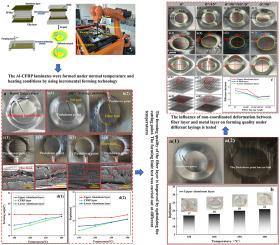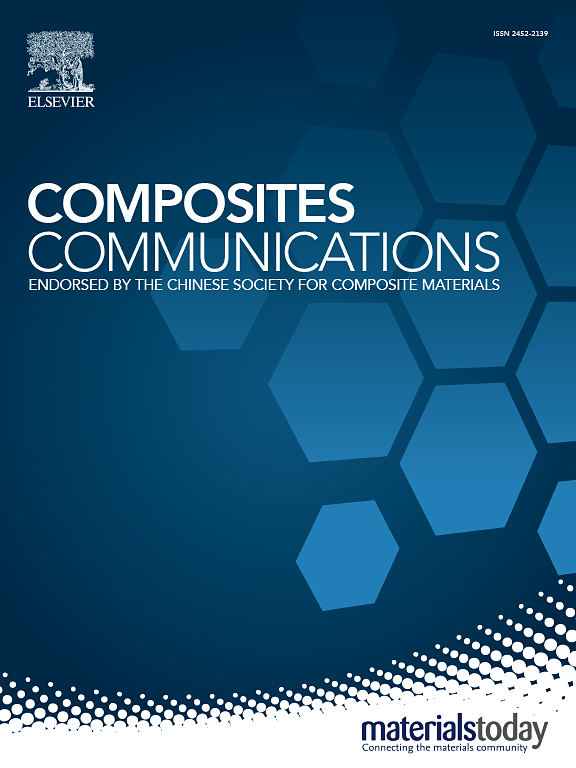界面特性对 Al-CFRP 复合材料层压板增量成型的影响
IF 7.7
2区 材料科学
Q1 MATERIALS SCIENCE, COMPOSITES
引用次数: 0
摘要
增量式成型技术是一种先进、灵活的制造工艺,无需模具即可成型部件,在试生产、快速原型和小批量制造复杂形状部件方面具有独特的优势。然而,由于碳纤维层的破坏性应变特性有限以及其界面结构的复杂性,高效制造 Al-CFRP 复合材料层压板面临着挑战。因此,探索使用增量成形技术生产 Al-CFRP 复合材料层压板的可行性,并研究界面摩擦特性对变形行为和成形缺陷的影响至关重要。通过改变成型温度,构建了各种界面摩擦条件,重点分析了 Al-CFRP 复合材料层压板的成型缺陷和变形规律。结果表明加热软化树脂后,Al-CFRP 复合材料层压板通过纤维层与金属层之间的相对滑动实现增量成形。当 Al-CFRP 复合材料层压板在相对较低的成型温度范围内表现出较大的界面摩擦力时,由于纤维桥接效应,金属层首先容易断裂。然后,随着温度的升高,界面摩擦力明显减小,金属层的断裂情况明显改善,但纤维层容易折叠。纤维方向通过界面应力传递明显影响金属层的变形行为。本文章由计算机程序翻译,如有差异,请以英文原文为准。

Influence of interfacial properties on incremental forming of Al-CFRP composite laminates
Incremental forming technology is an advanced, flexible manufacturing process that forms components without the need of mold, offering unique advantages in trial production, rapid prototyping, and small batch manufacturing of complex-shaped components. However, efficient fabrication of Al-CFRP composite laminates presents challenges due to the limited destructive strain characteristics of the carbon fiber layers and the complexity of their interfacial structure. It is crucial to explore the feasibility of producing Al-CFRP composite laminates using incremental forming technology and to examine the influence of interface friction properties on deformation behavior and forming defects. Various interfacial friction conditions are constructed by changing the forming temperature, focusing on the analysis of the forming defects and deformation laws of Al-CFRP composite laminates. The results demonstrated that. After the resin is softened by heating, the incremental forming of Al-CFRP composite laminates are feasible by the relative sliding between the fiber layer and the metal layer. When Al-CFRP composite laminates exhibit a large interfacial friction in a relatively low forming temperature range, the metal layer was easy to break first owing to the fiber bridging effect. Then, with the increase of temperature, the interface friction decrease significantly and the fracture of the metal layer was improved significantly, but the fiber layer was prone to fold. The fiber direction significantly affects the deformation behavior of the metal layer through interfacial stress transfer.
求助全文
通过发布文献求助,成功后即可免费获取论文全文。
去求助
来源期刊

Composites Communications
Materials Science-Ceramics and Composites
CiteScore
12.10
自引率
10.00%
发文量
340
审稿时长
36 days
期刊介绍:
Composites Communications (Compos. Commun.) is a peer-reviewed journal publishing short communications and letters on the latest advances in composites science and technology. With a rapid review and publication process, its goal is to disseminate new knowledge promptly within the composites community. The journal welcomes manuscripts presenting creative concepts and new findings in design, state-of-the-art approaches in processing, synthesis, characterization, and mechanics modeling. In addition to traditional fiber-/particulate-reinforced engineering composites, it encourages submissions on composites with exceptional physical, mechanical, and fracture properties, as well as those with unique functions and significant application potential. This includes biomimetic and bio-inspired composites for biomedical applications, functional nano-composites for thermal management and energy applications, and composites designed for extreme service environments.
 求助内容:
求助内容: 应助结果提醒方式:
应助结果提醒方式:


